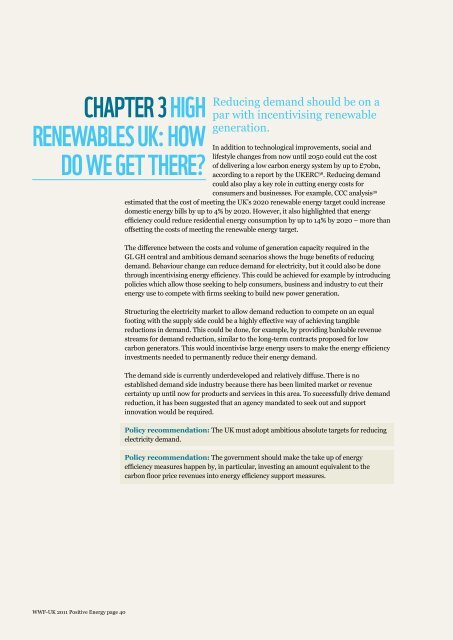Positive Energy: how renewable electricity can transform ... - WWF UK
Positive Energy: how renewable electricity can transform ... - WWF UK
Positive Energy: how renewable electricity can transform ... - WWF UK
You also want an ePaper? Increase the reach of your titles
YUMPU automatically turns print PDFs into web optimized ePapers that Google loves.
Chapter 3 HIGH<br />
RENEWABLES <strong>UK</strong>: HOW<br />
DO WE GET THERE<br />
Reducing demand should be on a<br />
par with incentivising <strong>renewable</strong><br />
generation.<br />
In addition to technological improvements, social and<br />
lifestyle changes from now until 2050 could cut the cost<br />
of delivering a low carbon energy system by up to £70bn,<br />
according to a report by the <strong>UK</strong>ERC 38 . Reducing demand<br />
could also play a key role in cutting energy costs for<br />
consumers and businesses. For example, CCC analysis 39<br />
estimated that the cost of meeting the <strong>UK</strong>’s 2020 <strong>renewable</strong> energy target could increase<br />
domestic energy bills by up to 4% by 2020. However, it also highlighted that energy<br />
efficiency could reduce residential energy consumption by up to 14% by 2020 – more than<br />
offsetting the costs of meeting the <strong>renewable</strong> energy target.<br />
The difference between the costs and volume of generation capacity required in the<br />
GL GH central and ambitious demand scenarios s<strong>how</strong>s the huge benefits of reducing<br />
demand. Behaviour change <strong>can</strong> reduce demand for <strong>electricity</strong>, but it could also be done<br />
through incentivising energy efficiency. This could be achieved for example by introducing<br />
policies which allow those seeking to help consumers, business and industry to cut their<br />
energy use to compete with firms seeking to build new power generation.<br />
Structuring the <strong>electricity</strong> market to allow demand reduction to compete on an equal<br />
footing with the supply side could be a highly effective way of achieving tangible<br />
reductions in demand. This could be done, for example, by providing bankable revenue<br />
streams for demand reduction, similar to the long-term contracts proposed for low<br />
carbon generators. This would incentivise large energy users to make the energy efficiency<br />
investments needed to permanently reduce their energy demand.<br />
The demand side is currently underdeveloped and relatively diffuse. There is no<br />
established demand side industry because there has been limited market or revenue<br />
certainty up until now for products and services in this area. To successfully drive demand<br />
reduction, it has been suggested that an agency mandated to seek out and support<br />
innovation would be required.<br />
Policy recommendation: The <strong>UK</strong> must adopt ambitious absolute targets for reducing<br />
<strong>electricity</strong> demand.<br />
Policy recommendation: The government should make the take up of energy<br />
efficiency measures happen by, in particular, investing an amount equivalent to the<br />
carbon floor price revenues into energy efficiency support measures.<br />
<strong>WWF</strong>-<strong>UK</strong> 2011 <strong>Positive</strong> <strong>Energy</strong> page 40

















